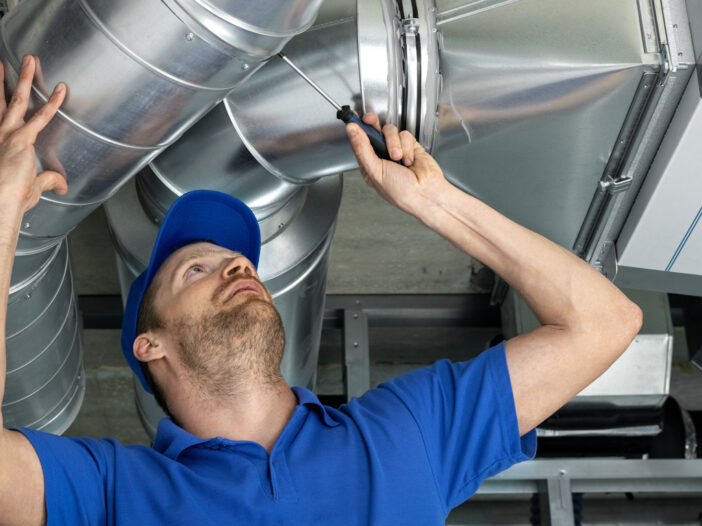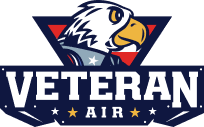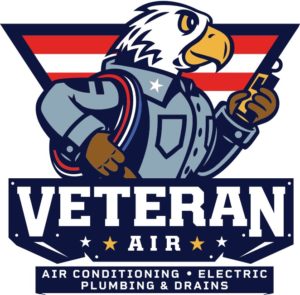
Homeowners know that the performance and security of your heating and cooling system is critical for ensuring a comfortable home atmosphere. Yet, one frequently disregarded hazard to your HVAC system is the presence of pests. These unwelcome intruders can inflict harm on your system and potentially impact your health and your family’s well-being. This article will highlight the hidden risks of pests within your HVAC system, how to identify signs of infestation, techniques for exterminating current pests, preventative actions to discourage their return, the significance of professional HVAC inspections and upkeep from Veteran Air, and the importance of establishing a plan for a pest-free HVAC system.
The Hidden Hazards of Vermin in Your HVAC System
Insects and rodent sneak into HVAC systems via small openings in ductwork, leading to an array of potential complications. For instance, they can can cause damage to system parts by establishing nests, producing waste, or physically affecting the integrity of the system.
Particular insects can introduce allergens and pathogens into your home’s living space can become a real concern. Presenting an additional threat, rodents like mice and rats may gnaw at wires, insulation, and the ductwork itself, escalating the chance of electrical fires while decreasing the efficiency of temperature regulation in the system.
Also, the presence of these unwanted guests can introduce moisture problems, leading to mold and mildew growth within the system, which may further degrade your home’s air quality. This problem can go beyond mere discomfort and pose a potential health hazard, particularly for individuals with existing respiratory issues.
Consider the financial ramifications as well. The cost of repairing damage inflicted by these pests can be considerable, affecting the ongoing operation and maintenance expenses of the HVAC system. So we can see that pest invasion in HVAC systems is not a minor nuisance. Instead, it’s a pressing concern requiring immediate, strategic intervention to ensure the safety of both the HVAC system and your loved ones.
Signs of Infestation
Recognizing the early signs of a bug or rodent infestation can prevent serious harm to your HVAC system and maintain the air quality in your home. Signs such as strange activity, unexpected noises, or an odd smell from the vents may suggest the presence of pests in your system. Unusual odors can often be attributed to the decay of pests or their excrements, while scratching, buzzing, or scurrying noises could suggest active pests in your ductwork. Visible evidence, like droppings or destroyed insulation near your HVAC units, calls for immediate attention.
Additionally, a sudden rise in allergic reactions or respiratory problems among household members may indicate allergens caused by pests through the air system. Monitor any visible damage to your HVAC unit or ductwork, as these could serve as potential pest entry channels. Being vigilant about these signs can help prevent extensive damage, safeguard your home’s health and comfort, and ensure continued optimal operation of your HVAC system.
Getting Rid of Existing Infestations
If you detect the presence of insects or pests in your HVAC system, immediate intervention is key to safeguard your indoor air quality and maintain your system’s durability. The first course of action is to engage the services of a pest control specialist. This expert is able to correctly identify the type of intruder, discover their breeding areas, and pinpoint their ingress routes into your system. They use safe and efficient procedures to eliminate these nuisances, guaranteeing a pest-free residence without jeopardizing your HVAC system or posing health risks to the members of your household.
Next, you’ll want to tackle the source of the infestation to thwart recurrent invasions. Generally, this entails fortifying your HVAC system against potential breaches. An essential part of this involves sealing identified entrances such as holes or cracks in the ductwork which allow pest access. You should enlist help from an HVAC expert from Veteran to ensure complete and thorough sealing of entryways without hindering system performance.
Subsequently, inspect the surrounding area of your external HVAC units and implement required alterations to ward off pests. Implementing basic measures such as clearing debris, pruning overgrown vegetation, and draining stagnant water in close proximity to your HVAC system can considerably lower its appeal to pests seeking a new habitat.
Promptly undertaking these steps upon pest detection in your HVAC system not only addresses the immediate concern but also establishes a solid foundation for a pest-resistant environment. By joining forces with pest control and Veteran Air’s HVAC professionals, you will not only restore but also maintain the efficiency and wellness of your HVAC system, ensuring its continuous safety within your home.
Keeping Pests at Bay
Implementing a proactive pest management strategy can help protect your HVAC system from the intrusion of insects and vermin. It begins with an in-depth inspection of your home exterior, including the foundation, walls, and notably the HVAC ductwork. Any gaps should be meticulously sealed with appropriate materials like caulk, foam sealants, or mesh screens. This creates a strong, lasting barrier that eliminates possible pest entry channels.
Ensuring cleanliness in your living spaces, both indoors and outdoors, dramatically lessens their attractiveness to pests. Quick clean-up of food leftovers and spills, and proper waste storage and disposal are important. Also, minimizing clutter in secluded areas such as basements, attics, and wardrobes, can deprive pests of potential breeding grounds.
A well-maintained outdoor area also aids in pest prevention. Regularly trim the greenery around your HVAC system to maintain a safe distance between them and your home. Shrubs and tree limbs close to your house or HVAC system could create convenient routes for pests. Keep your gutters and downspouts clean and dry to avoid creating a moist environment that pests find attractive.
Adding vent covers and flue caps to your HVAC system enhances the protection. They promote unrestricted airflow while barring pests from infiltrating your home via vents, exhaust outlets, and chimney openings.
With these preventive steps in place, you set up a dynamic defense against insects and vermin, prolonging the lifespan and efficiency of your HVAC system. Plus, it guarantees better indoor air quality and a comfortable home atmosphere.
Why Professional HVAC Inspection and Maintenance is Crucial
To keep your HVAC system pest free and working at peak performance, engage the experienced HVAC technicians at Veteran Air. Our skilled technicians meticulously examine your system, focusing on potentially compromised or susceptible areas due to pests such as insects and rodents. Regular upkeep by our team enables the early detection of pest indicators that homeowners may miss, like subtle ductwork damage or organic debris accumulation that tends to lure pests.
HVAC maintenance extends beyond just pest mitigation. A thorough assessment of the system’s efficiency assures the smooth and optimum performance of all its components. This not only curbs unexpected malfunctions but also boosts your home’s overall energy efficiency, with the potential to cut down on utility expenses. The HVAC specialists from Veteran Air can provide professional guidance on sealing the ductwork. They are adept at proposing solutions that deter pest invasions without hampering airflow. Armed with specialized know-how and the right tools, they fortify your system against pests while upholding its peak performance.
Scheduled upkeep sessions with our HVAC technicians serve a two-fold purpose: Protecting your system against the damaging impact of pests and maintaining indoor air quality, thereby fostering a healthier and more pleasant living space.
Creating a Long-Term Strategy for a Pest-Free HVAC System
Establishing a long-term strategy to prevent pests from infiltrating your HVAC system involves consistent effort and a proactive stance. Key to this approach is regularly scheduled inspections and maintenance by the HVAC professionals at Veteran Air. These experts not only ensure the system’s operational efficiency but also help identify vulnerabilities that could invite pest intrusions.
Engaging in regular cleaning and maintenance of both the interior and exterior areas surrounding your HVAC units significantly reduces the likelihood of pest harborage. This includes managing debris, ensuring proper sealing of ductwork, and maintaining a clutter-free area around HVAC installations.
Additionally, certain habits can deter pest attraction, such as secure trash management and minimizing standing water. Keeping a vigilant eye out for signs of pest activity allows for immediate action, preventing small issues from escalating into larger infestations.
By weaving these practices into the fabric of your home maintenance routine, you lay down a solid foundation for a durable, pest-resistant HVAC system. This strategic approach not only protects the system but also upholds the health and comfort of your living space, ensuring peace of mind and a secure environment for years to come.


